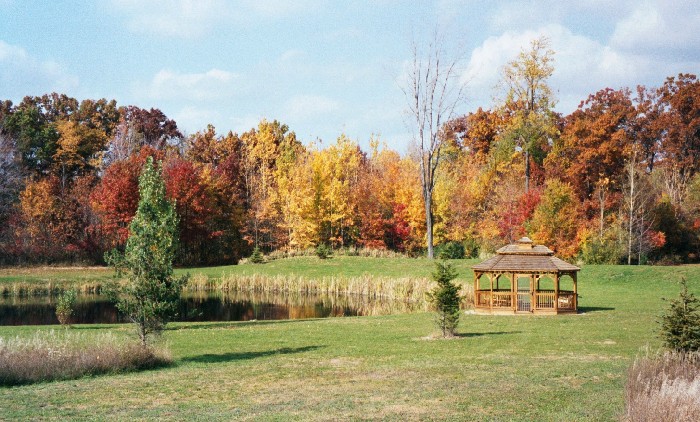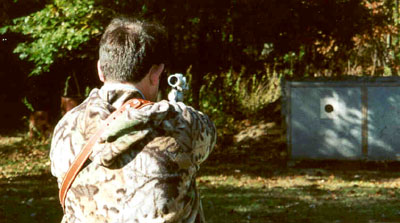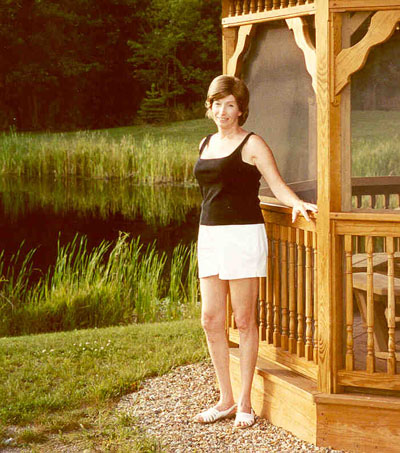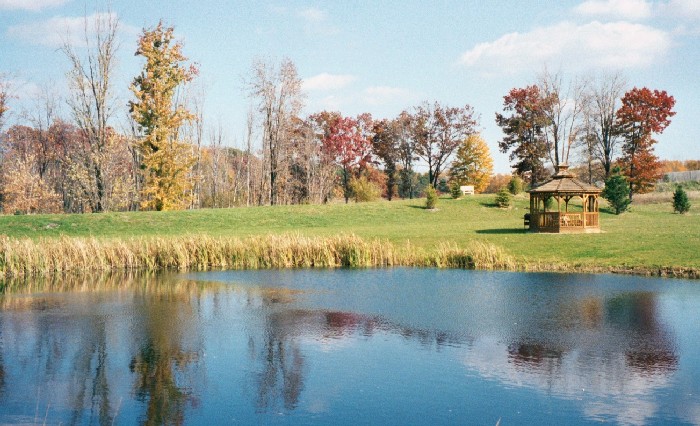by Lynn Conway
Copyright @ 2000-10 Lynn Conway. All Rights Reserved

by Lynn Conway
Copyright @ 2000-10 Lynn Conway. All Rights Reserved

Since then, we've enjoyed landscaping the old agricultural parts of the property - planting trees and shrubs, putting in walking trails and roads through our woods, and digging a big pond. We've obtained many plants as seedlings at annual spring "tree sales" of the Jackson County Conservation District, and many others from Gee Farms, a wonderful nursery in Stockbridge, MI. Along the way, we developed an interest in more fully enhancing and diversifying the natural landscape of our property. This is a long-term project to increase the varieties and diversity of the native grasses, wildflowers, shrubs and trees on our property. We've also worked to attract lots of wildlife onto the property, using information in books such as Managing Michigan's Wildlife: A landowner's guide by the Michigan DNR.
Over the years we've added diverse species of plants, removed invasive species, encouraged native species that pioneered into our land, thinned close-growing trees in our woods and added fence-rows of thickets to improve wildlife access across open fields. For references about natural landscaping and habitat improvement, see Noah's Garden: Restoring the Ecology of Our Own Back Yards, by Sara Stein, Houghton Mifflin, 1993 and also, Planting Noah's Garden: further Adventures in Backyard Ecology, by Sara Stein, Houghton Mifflin, 1998, and also refer to the Wild Ones national web-site for more background on restoring native landscapes. Books that capture the wild spirit and beauty of such landscapes are Native Trees for North American Landscapes by Guy Sternberg, The American Woodland Garden: Capturing the Spirit of the Deciduous Forest by Rick Darke, and The Wild Garden: Expanded Edition, by William Robinson and Rick Darke. I highly recommend them to you.
Although our property isn't large (at 23 acres), it's located in an area that is topographically quite varied and complex. As discussed in the USGS references below, ours is an area of steep, sandy end-moraine ridges and flat, sandy outwashes from the past ice-age glaciers. Kettle lakes, formed when huge ice-blocks later melted within the outwash, are often bordered by broad wetlands, including marshes, wet meadows, and prairie fens. At the time of European settlement, the uplands supported savannas of white oak and black oak; with fire exclusion, these savannas have mostly converted to oak forest. Our property includes all of these types of terrain. Our land also borders a large undeveloped wetland, and given the complexity and variety of our terrain the property seems much larger that its actual acreage. (A regional landscape ecosystems map is provided at this USGS link, with our subsection described at this link).
By taking the property back to nature this way, we're able to enjoy year-around recreation in secluded privacy right in our own "back yard" – taking long nature walks, observing and studying plants and wildlife, riding our mountain bikes and dirt bikes, swimming in our pond, snow-shoeing and cross-country skiing in winter, target shooting on our practice range, observing with astronomical telescopes under dark rural night skies , and working on an ever-increasing variety of landscaping and nature preservation projects. The following menu contains links to various pages of photos of our home and landscape taken over the years (the "Northwoods Cabin" page is new):
Our home and landscape:
Some early photos from 1998-2000
Our country home in the early fall
|
And in Winter: There are two barns behind the house; one is insulated and heated
|
|
A close-up reveals traditional landscaping out in front
|
But the 23 acres out back holds lots of promise for natural landscaping with vistas of ponds, marshes, prairie and woods, 1998
|
|
We put in this swimming pond in the summer of 1998 120' by 160' in size, it's mostly 7' to 8' deep
It's kept clear using CuSo4, and kept warm on the surface and cool on the bottom by using a sun-screen treatment
|
|
|
Lynn swimming in the pond in August '99. It's fun to loll about in the pond using PFDs for flotation.
|
Elsewhere there are many natural ponds, marshes and swamps
In the center of this photo we see a Canada Goose nesting on a tiny grassy island in one of our natural ponds
|
|
all over the place, including this somewhat confused little Raccoon
We see Sandhill Cranes grazing in our fields, Mallards & Wood Ducks in the swamps, and Redtail Hawks catching small critters |
Inside the big barn showing some of Charlie's toys:
|
|
Including in winter, when the swamps and ponds are frozen and snow-covered
|
|
|
Of course, rural living in snow country requires a degree of self-reliance.
Here Charlie uses our medium snow equipment; in the winter of '98-99 we had to use our 36HP tractor/loader to move the snowdrifts!
|
View of the pond from our gazebo, in the summer of '00
It's about 1/5 mi from our house, in the wooded area of our property.
|
Charlie practicing with his .44 Magnum hunting revolver.
We've set up a shooting range with shooting points out to 200yards.

Looking downrange as Charlie fires his .44


With screens in place, we often have cookouts here,
sometimes even "camping-out" here overnight .
Looking East across our pond, in the fall of 2000.
